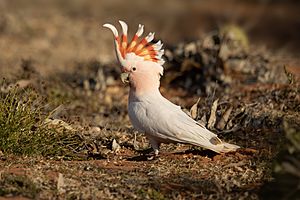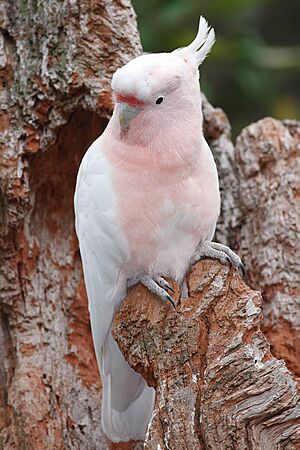Pink cockatoo facts for kids
Quick facts for kids Pink cockatoo |
|
|---|---|
 |
|
| Pink cockatoo with its crest raised in New South Wales, Australia | |
| Conservation status | |
| Scientific classification | |
| Genus: |
Cacatua
|
| Species: |
leadbeateri
|
| Subspecies | |
|
C. (L.). l. leadbeateri (Vigors, 1831) |
|
 |
|
| Pink cockatoo range (in red) | |
| Synonyms | |
|
Plyctolophus leadbeateri Vigors, 1831 |
|
The pink cockatoo (Cacatua leadbeateri) is a beautiful medium-sized bird. It is also known as Major Mitchell's cockatoo or Leadbeater's cockatoo. These birds live in dry and semi-dry areas across Australia, but not in the far north-east.
Contents
About the Pink Cockatoo's Name
The pink cockatoo got its first scientific name, Plyctolophus leadbeateri, in 1831. This name was given by an Irish scientist named Nicholas Aylward Vigors. He named it after Benjamin Leadbeater, a naturalist who gave Vigors the first bird specimen to study.
For a long time, the bird was officially called "Major Mitchell's cockatoo". This name came from Major Thomas Mitchell. He was an explorer who wrote about how beautiful this bird was in his books. He even called it the "cockatoo of the interior."
However, in 2023, the official name was changed back to "pink cockatoo". This change was made by BirdLife Australia. It happened because of Major Mitchell's past actions and a general effort to use more respectful and inclusive names for species.
People have used many other names for this bird over time. Some of these include desert cockatoo, chockalott, and wee juggler. In the Pitjantjatjara language, spoken in Central Australia, it's called kakalyalya.
What Does a Pink Cockatoo Look Like?

The pink cockatoo has soft feathers that are white and salmon-pink. It has a large, bright red and yellow crest on its head. This crest can be raised when the bird is excited or alarmed.
Male and female pink cockatoos look very similar. Males are usually a bit bigger. Females have a wider yellow stripe on their crest. When they grow up, female pink cockatoos also develop red eyes.
Reproduction and Life Cycle
Pink cockatoos become old enough to have babies when they are about 3 to 4 years old. These birds can live a very long time! The oldest pink cockatoo ever recorded lived to be 83 years old.
Where Pink Cockatoos Live
Pink cockatoos live in pairs or small groups. They look for food both on the ground and in trees.
Unlike some other cockatoos, pink cockatoo numbers have gone down. This is because of changes humans have made to their homes in Australia. They need large areas of woodland, especially with certain types of trees like conifers, sheoak, and eucalypts.
Pink cockatoo pairs do not like to nest close to other pairs. This means they cannot live in areas where the land is broken up or partly cleared. Because of this, the areas where they live are getting smaller.
Sometimes, in a region called the Mallee in Victoria, pink cockatoos and galahs nest in the same areas. When this happens, they can sometimes have mixed-breed babies.
Protecting Pink Cockatoos
The pink cockatoo needs protection.
In Australia
The Australian government lists the pink cockatoo as an endangered species. This means it is at a very high risk of disappearing from the wild.
In Victoria
- In the state of Victoria, the pink cockatoo is listed as a threatened species.
- There is a special plan to help this species recover and manage its future.
- On a list from 2013, the pink cockatoo was called a vulnerable species in Victoria. This means it is at risk of becoming endangered.
Pink Cockatoos as Pets
"Cookie" was a famous pink cockatoo. He lived at the Brookfield Zoo near Chicago in Illinois. Cookie was at the zoo from the day it opened in 1934 until he passed away on August 27, 2016. He was 83 years old when he died! Cookie had stopped being on public display in 2009 because he was not feeling well.
Images for kids
-
"Plyctolophus leadbeateri, Leadbeater's Cockatoo" in Lear's influential 1832 monograph.
See also
 In Spanish: Cacatúa abanderada para niños
In Spanish: Cacatúa abanderada para niños





